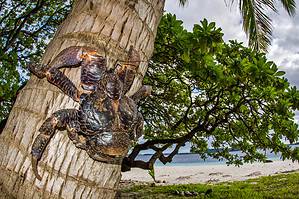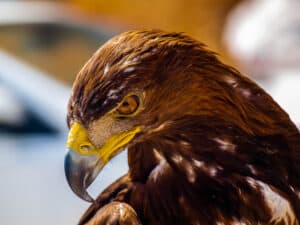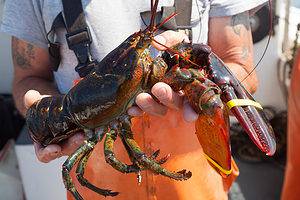What do lobsters eat, exactly? Historically, lobsters were assumed to be mostly scavengers, consuming decaying organic matter. However, lobsters primarily eat fresh food which includes shrimp, sea urchins, plant life, mollusks, and even other lobsters, although rare.
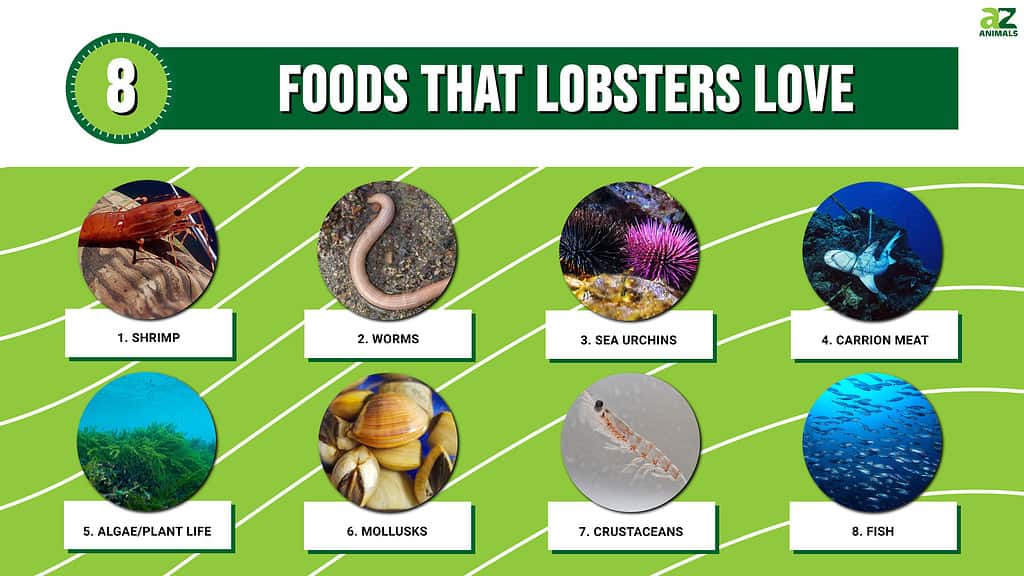
Lobsters are omnivorous and will hunt for food all day long. If there is access to food, they will eat it. In times of need, they can even alter their diet. They prefer to hunt at night and hide from predators during daylight. According to scientists that research lobsters, they are as intelligent as octopuses, which have long been thought of as the world’s most intelligent invertebrate. Let’s dive into the full details to answer, “What do lobsters eat?”

Do Lobster Eating Habits Vary by Species?
What do lobsters eat by species? The diet of lobsters varies by species. The Spiny Lobster and the Clawed Lobster are the two main types, or families of lobsters. Believe it or not, but there about 60 species of spiny lobsters and more than 50 species of clawed lobsters!
Clawed Lobster
The most famous types of clawed lobsters are the American and European. North Americans are best familiar with the American Lobster, which is collected off the coasts of Maine and other New England states, as well as near Canada’s Atlantic Provinces. European Lobsters are found in the eastern Atlantic Ocean from northern Norway to Morocco and the Azores. They are found in the Mediterranean Sea west of Crete and the Black Sea.
Spiny Lobster
This lobster is a warm-water crustacean. Spiny lobsters are found off the coast of California, near Florida, and in the Caribbean Sea. In fact, they constitute the Bahamas’ largest food export. They are also found near Australia, New Zealand, Papua New Guinea, and other southeast Pacific islands, as well as along the South African coast.
The spiny variant has large antennae for movement detection and is covered with spines to evade predators. These lobsters have five identical legs instead of huge front claws, like the American or European Lobster.
What Do Lobsters Eat?
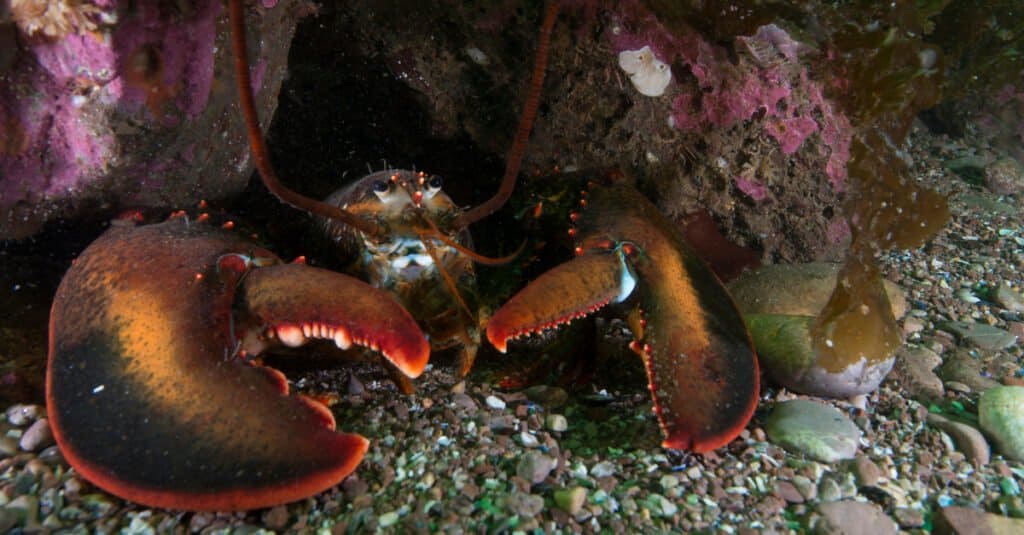
Lobsters will eat anything they can get their claws on, whether dead or alive.
©RLS Photo/Shutterstock.com
Lobsters eat shrimp, mussels, worms, urchins, carrion, algae, mollusks, crustaceans and even other lobsters. As we noted above, what lobsters eat will depend on the species. We’ll dive into some of their favorite prey below:
Shrimps
Yes, lobsters do eat shrimp. Shrimp are the primary food source for Caribbean furry lobsters.
Worms
Lobsters may eat a wide variety of marine worms, including flatworms, roundworms, arrow worms, and horseshoe worms.
Sea Urchins
Spiny lobsters enjoy consuming sea urchins as a source of nutrition. On the sea floor, many kinds of sea urchins can be discovered, and they will eat all of them!
Carrion Meat
Most lobsters, particularly spiny lobsters, will feed on carrion meat that they discover drifting around on the bottom or in the water. They’ll consume any meat they can get their claws on.
Algae/Plant life
Both American and European lobsters enjoy algae. Because lobsters live on the seafloor, they can easily feed on algae which grows in abundance there. Algae come in a wide variety, and lobsters consume them all. Some lobsters also eat zooplankton and flowering plants.
Mollusks
Both American and Caribbean spiny lobsters eat mollusks. There are 85,000 mollusk species. Lobsters will devour any of these species that live on the seafloor they can find.
Crustaceans
American and spiny lobsters both eat crustaceans. These hard-shelled arthropods are the ones you see on the beach, like prawns, krill, barnacles, and crayfish. Lobsters eat a wide range of sea creatures.
Fish
Clawed lobsters like the American and Marine lobsters enjoy eating fish. When hunting, they will sit and wait out little fish as they pass by. The lobster’s claws will catch the fish so fast; they won’t even know what hit them.
How Do Lobsters Find Their Food?
Lobsters frequently hunt for food at night. To find their prey in the dark, Lobster’s “smell” using four little antennae on their heads and detecting hairs all over their bodies. Their smell is so sensitive that they can detect a single amino acid in their favorite foods.
Lobsters eat more as they lose their old shells because they require calcium to rebuild it. A newborn lobster will eat an 8cm jellyfish in four days.
Do Lobsters Eat Other Lobsters?
Lobsters do eat other lobsters. Traditionally this behavior occurs mostly in captivity in conditions where lobsters are placed in confined conditions. However, that may be changing.
Wild lobsters are omnivores, which means they’ll consume about anything they come across in the water or on the ocean floor. In recent experiments where scientists left young lobsters as bait, they were surprised to find that the most common predators of the young lobsters were adult lobsters. We’ve embedded a video of these lobsters exhibiting cannibalism below.
The bottom line is that lobsters will eat other lobster species and even their own young if alternative foods are not accessible to them or if the other lobster is tiny enough to catch and devour. Your lobsters will also eat any other animal in the aquarium, including fish and shellfish.
With lobster populations growing – thanks in part to rising sea temperatures off the coast of Maine and other northerly locations – they’re more likely to see other lobsters as a food source.
Do Lobsters Eat Their Shell?
It is common for lobsters to devour their own shells when they have recently molted. By absorbing water, they battle out of their old shells and grow larger. Lobsters may try to devour their old shells after molting to help harden their new shells faster.
During the first 5-7 years of a lobster’s existence, it sheds its shell approximately 25 times. The hardening of the new shell is accelerated by this replenishment of the calcium that was lost during the removal of the old shell, which takes between 14 and 30 days. As lobsters age, the molting of their shells becomes incredibly energy-intensive and eventually older lobsters simply cease molting. Lobsters who have stopped molting begin getting infections in their shells, which is usually the leading cause of death for the world’s oldest lobsters.
How to Feed A Lobster In A Tank
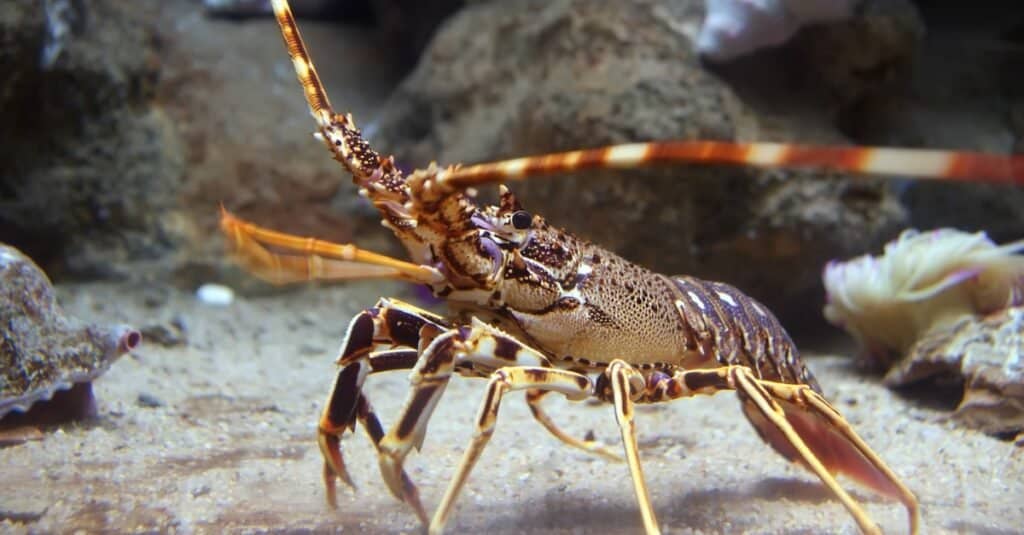
Pet or captive, lobsters eat pellets, shrimp, crabs, and other seafood.
©VLADJ55/Shutterstock.com
What do lobsters eat when living in a tank? Lobsters in a tank usually eat a combination of live seafood and pellets. In the wild, lobsters eat a wide variety of sea creatures in the wild, including oysters, clams, mussels, fish, and starfish. With the popular tank species of spiny lobster, a combination of pellets and various seafood is necessary to sustain them. You can get vegetation-based pellets at pet stores.
A range of foods such as crabs and shrimp, as well as other seafood, should be included in the diets of captive lobsters to keep them healthy. Because of a lack of natural food and boredom, they are significantly more prone to resort to cannibalism when kept in captivity.
Summary Of The Top 8 Foods That Lobsters Love
| # | Top Lobster Food |
|---|---|
| 1 | Shrimp |
| 2 | Worms |
| 3 | Sea Urchins |
| 4 | Carrion Meat |
| 5 | Algae/Plant life |
| 6 | Mollusks |
| 7 | Crustaceans |
| 8 | Fish |
The photo featured at the top of this post is © davemhuntphotography/Shutterstock.com
Thank you for reading! Have some feedback for us? Contact the AZ Animals editorial team.



